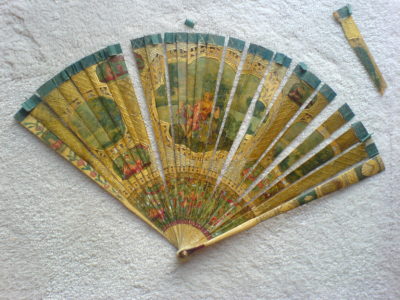Conservation and Repair of Fans
A review of the available books and articles on this subject quickly reveals that there is no common agreement on how to best conserve or repair fans. The conservation purist would say that the minimum work should be undertaken to stop the fan from worsening in condition – and always undertake this with reversible techniques so that if better ones become available in the future they can easily be employed. However from a personal home point of view, making the fan possible to display safely may be the objective. We can therefore only provide some very rough guidelines to this subject on this web site. The FCI accepts no responsibility for any problems arising from following the general advice on this page. If the fan is at all valuable then expert advice should be sought before attempting a repair.
Buying broken fans – what’s easy to mend and what’s not
Some fans are much easier to repair than others. A brisé fan with no ribbons may look a sorry sight but is relatively easy to repair if all the sticks are there and in good condition.
Sellotape is almost impossible to get off fans – or at least the glue deposit it leaves behind.
Never use sellotape to repair a fan!
Paper leaves are relatively easy to mend using very thin paper and starch based glue, also to repaint patches if you want to take it that far.
Splits in gauze and fine silk leaves are very hard to repair satisfactorily, and there is no way of stabilising silk which has gone crumbly. This particularly applies to white silk and gauze as the bleaches that were used to whiten them cause the fabric to break down. So avoid buying white gauze and silk fans with splits down the folds for repair, it will be very difficult. The only answer really is to back the whole fan with a supporting fabric such as nylon gossamer fabric or fine net.
Sticks are generally harder to repair than leaves. Even if all the stick pieces are there, it is hard to make an end-to-end joint which will withstand handling. Splinting the joint may be an option, but it can be unsightly. A proper repair involving chamfering the sticks to make a seamless joint is easier written than done, and you might prefer to seek the aid of a professional repairer.
Glues
The conservation viewpoint is that all glues used should be reversible (preferably water soluble) so that if at a later date a better technique or glue arrives, the fan can be re-conserved without damage. In practice the glue needed to repair broken fans depends on what is being repaired and how valuable the fan is.
The best glue for paper (mending leaves) is a starch based glue with no additives. White Gloy (NOT brown Gloy gum) is suitable here. For repairing fabrics or backing leaves with gossamer fabric, special fabric glues are available (eg Texicryl from Picreator). Some of these glues require heat bonding to be successful. Sticks will need to be repaired with a stronger adhesive which does not run. Super Glue Gel may be most successful here.
Storage of Fans
Many of us started to collect fans because they were an inexpensive way of displaying something decorative on the wall. Imagine our dismay on finding that fans become damaged by being permanently on display, and should really be stored folded up in a dark place! In reality, fan display is really a matter for personal discretion, bearing in mind that fans can be damaged by light and dust and that leaving them open for a long time can mean that they won’t close again later. We would not recommend leaving a valuable fan open on display permanently, even in a glass case. It is probably best to rotate the fans which you have on display at home. However a glass case can be a perfect vehicle for a damaged and repaired fan which is too fragile to be folded up again.
The received wisdom on storage of fans is that they should be stored folded, on their side (rivet down to prevent the folds getting damaged) and wrapped in acid free tissue paper. Storage in cardboard boxes unless acid free is not recommended. Some people even prefer not to store fans in their original boxes as they were not acid free.
If you have a lot of feather and fabric fans you might want to consider using a fungicide before storage. Insect and mildew damage is less of a problem in the UK but can be a problem in warmer areas of the world.
Re-ribboning Fans

Re-ribboning fans is a relatively straightforward process and although it does require patience it is probably the most rewarding aspect of fan repair and conservation. How satisfying to turn a bundle of sticks into a working fan again with simple piece of ribbon and some glue.
Ribbon
Ideally ribbon should be selvedge free (modern ribbon is too wide and bulky for a fan) and in a silk to match the width and colour of the original. If a fragment remains you can choose something as close as possible. Silk ribbon is obtainable from specialist suppliers and also from the Fan Circle for members.

In order to thread the ribbon through the slots on fan sticks, the end will need to be made rigid. This can be achieved by glueing a corner of paper over the ribbon and leaving it to dry. It can then be cut into a point for threading. If a finer point is required because the slots are very fine, try using fray check on the ribbon end before cutting to a point.
Adhesive
White PVA glue should be used, preferably reversible (water soluble).
Types of re-ribboning
There are three basic arrangements of slots for re-ribboning:
- 3 holes in each stick
- one hole in each stick with a continuous ribbon
- one hole in each stick with ribbon cut in short lengths.
The techniques are slightly different in each case:
Three Holes
In this case a continuous ribbon is used. This is probably the easiest type of fan to re-ribbon. Starting at the Right Hand Side of the fan, leave the guards until last. Thread the ribbon down through the first hole, up through the second and down through the third. Glue to the sticks on the back between the first and second slots. Make sure you leave just enough ribbon to open the fan fully before glueing the next stick. Leave the work to dry between each stick.
Stick the ribbon to the guards if it went all the way across. If it only want half way across, glue the ribbon on from the centre point outwards, with a turnunder to stop the ribbon fraying.
One hole – continuous ribbon
With a continuous ribbon, thread the ribbon down through the first hole. Turn the fan over and glue the ribbon to the stick half way across in the direction of threading. Again, ideally leave it to dry before taking the ribbon down through the next hole.
One hole – one piece of ribbon per stick
Cut pieces of ribbon approximately the width of two sticks (use any existing ribbon as a template). Glue half of the ribbon to the right side of each stick and leave to dry. Then feed down through that stick and down through the next stick. Feed under the next stick and glue to the back in the direction of threading. Make sure that the fan opens to the right degree before leaving to dry. Repeat this with subsequent pieces of ribbon. Trim off any excess ribbon and attach to guards in a similar way.
Re-ribboning is also described in Nancy Armstrong’s “The Book of Fans”
Conservation Articles from the FCI Bulletin
- Conservation of Two 18th Century Fans by Maria Jose Taxinha, Jose de Figueiredo Institute, Lisbon. – Bulletin 19 P27
- The Conservation of Fans by Dr J Ashley-Smith – Keeper of the Department of Conservation at the V&A – Bulletin 27 P25
- Care and Conservation – Re-ribboning and rethreading brise fans by Margaret Dobbie – Bulletin 15 P29
- Care and Conservation – Cleaning Ivory fans by Margaret Dobbie – Bulletin 11 P14
- Care and Conservation – Displaying Folding Fans by Avril Hart – Bulletin 11 P12
- Visit to the Textile Conservation Centre, Hampton Court, 1977 – Bulletin 5 P5
- The Conservation of a French 19th Century Organza Fan Leaf – Christine Lachelin, Glasgow Museum – Bulletin 66 P32
Book Information:
- Textile Conservator’s Manual, V and A
By Sheila Landi
Pub: Butterworth and Heinemann
ISBN 0750603526 - Nancy Armstrong’s “The Book of Fans” contains a thorough chapter on fan repairing.
Where to buy Conservation materials
Jacqueline and Michael Hyman
The Textile Restoration Studio,
2 Talbot Road,
ALTRINGHAM
Cheshire WA14 3JD
UK
Spatula Iron and Conservation Lighting and equipment
CLE Design Ltd,
69 Haydons Road,
London
Picreator Enterprises Ltd
44 Park View Gardens
London
NW4 2PN
UK
Tel:- 0208 202 8972
